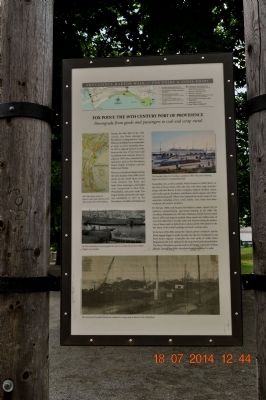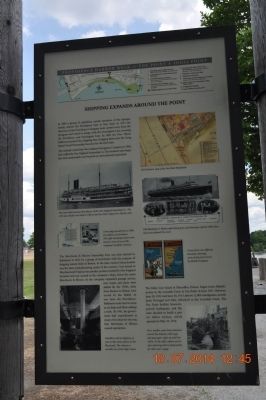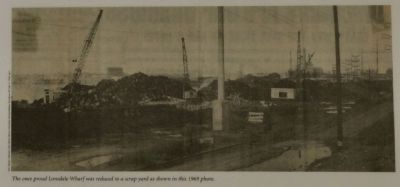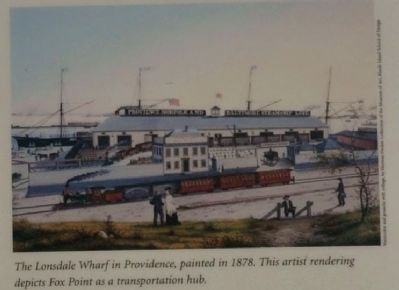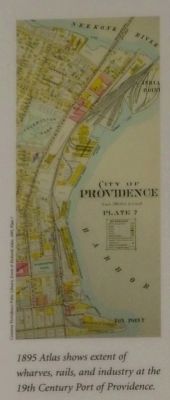Fox Point in Providence in Providence County, Rhode Island — The American Northeast (New England)
Fox Point: The 19th Century Port of Providence / Shipping Expands Around the Point
Downgrade from goods and passengers to coal and scrap metal
Inscription.
Providence Harbor walk at Fox Point & India Point
1. Fox Point and Night Boat Era 1822-1932 Firefly challenges the Stagecoach Era
2. Colonial Wharf at South Water Street: 1910-1942
3. Fox Point Hurricanes Barrier 1961-1966 Construction and 2005-2007 changes from I-I95 relocation
4. Providence River Bride Its design, construction and journey up Narragansett Bay by tugboat
5. Shipping Expands around the Point
6. Fox Point: the 19th Century Port of Providence Downgrades from goods and passengers to coal and scrap metals
7. Welcome to India Point Park
8. Welcome to Fox Point
9. Tockwooten and the Indiamen Ship building and trade with Orient India Point
10. Sails to Rails 1835: Providence’s First Train Station
11. Bridging the Seekonk
12. Rogers Williams Landing 1636
Fox Point:
The 19th Century Port of Providence (Side 1)
Downgrade from goods and passengers to coal and scrap metal
During the first half of the 19th century, Fox Point emerged as Providence’s transportation center. Wharves multiplied to accommodate as many as seven steamships lines. In 1835, a railroad opened on India Street at the foot of Ives Street and its railroad track network, shown in adjacent 1895 atlas, attracted a new industries, such as the Providence Steam Engine Company and the Fuller Iron Works.
The era of steamboats began during the early decades of the 1800s. From docks on the south shore of the Neck, between Fox Point and India Point, passengers and freight were transported to New York, Philadelphia, and ports south. The largest facility, pictured to the right, was established in 1875 by the Providence, Norfolk and Baltimore Steamship Line, at the Lonsdale Wharf located on India Street, at the foot of Hope Street. Here the Line with three large steamers along with the Brown & Ives Company shipped finished cotton and woolen goods, hardware, machinery, steam engines and other manufactured goods. These were balanced by return cargos of raw materials, including cotton, wool, leather, iron, hides and other southern and western products.
By the late 1800s coal became Providence’s major import for its industry, transportation, and home heating. In his 1886 The Providence Plantations for 250 Years, Welcome Arnold Greene noted that in 1878, cola imports peaked when nearly one million tons of coal were delivered to storage yards and wharves along the harbor. One of those yards in India Point is shown in the 1891 photo to the left. Many of the wharf’s pilings survived a century later.
By the turn of the 20th century the “electric power revolution” and the diesel engine began to make inroads into the use of industry’s
coal fired steam engines. Gradually the coal yards of India Point disappeared only to be replaced by the scrap metal yard pictured below. The Port of Providence moved south to the deeper waters off Allens Avenue, leaving Fox Point abandoned and desolate in its wake.
1895 Atlas Shows extent of wharves, rails, and industry at the 19th Century Port of Providence.
The Lonsdale Wharf in Providence, painted in 1878. This artist rendering depicts Fox Point as a transportation hub.
By 1891 mountains of coal occupied the wharves at India Point where China Clippers once docked.
The once proud Lonsdale Wharf was reduced to a scrap yard as shown in this 1969 photo.
(Side 2)
In 1864 a group of capitalists, mostly members of the Spargue family, started the Providence Line to New York. In 1873 the directors of the Providence Company took control away from the Spragues and voted to merge with the Stonington Line, forming the Providence and Stonington Line. In 1892 the New Haven Railroad acquired the shipping line, bringing them into the Long Island Sound Steamship business for the first time.
The railroad created the New England Navigation Company in 1904, later called the New England Steamship Co. The steamers were large, fast and comfortable and boasted an international reputation.
The steel hulled steamer
Providence of the New England Steamship Co. The 379’ side-wheel was built in 1905 at the Fore River shipyard in Quincy, MA.
A two-page spread from a 1930s Providence Line brochure. The right hand page shows some interior views of one of the company’s propeller steamers.
The Merchants & Miners Steamship Line was first started in Baltimore in 1852 by a group of merchants with the purpose of shipping tanned hides to Boston. At the time, eastern Massachusetts was the shoe-manufacturing center of the country. Coal mined in Maryland and Virginia was another product needed by New England factories and was carried in the company’s ships, hence the name Merchants & Miners. As the company expanded passage service, new routes and ports were added. By the 1920s, cities from Boston to Miami were served by the M&M. At one time, the Providence-Baltimore route had as many as six ships and three sailings a week. By 1941, the government had requisitioned so many of its ships for the war, that Merchants & Miners ceased operations.
Travellers rode in elegance, as seen in this main saloon on the Plymouth. The column is actually one of the ship’s masts.
1918 Sanborn map of the Fox Point Waterfront.
Old Merchants & Miners advertising post cards showing a typical 1920s liner and scenes aboard the vessel. Covers from two different brochures
showing some of the ports served by M&M Company.
The Fabre Line based in Marseilles, France, began trans-Atlantic service to the Lonsdale Dock in Fox Point in June 1911. Between June 30, 1912 and June 30, 1913 almost 12,000 immigrants, mostly from Portugal and Italy, debarked at the Lonsdale Dock. The Fox Point facility, however proved inadequate, and the state decided to build a pier on Allens Avenue, which opened on May 23, 1914.
On a smaller scale, these schooners crossed the Atlantic with cargo and passengers right up until the 1950s. To the right, sailors can be seen repairing sails in preparation for their next voyage.
Topics. This historical marker is listed in these topic lists: Industry & Commerce • Waterways & Vessels. A significant historical month for this entry is May 1876.
Location. 41° 49.066′ N, 71° 23.677′ W. Marker is in Providence, Rhode Island, in Providence County. It is in Fox Point. Marker is on India Street. Marker located in India Park near the Seekonk River. Touch for map. Marker is in this post office area: Providence RI 02903, United States of America. Touch for directions.
Other nearby markers. At least 8 other markers are within walking distance of this marker. Welcome to India Point Park / Welcome to Fox Point (about 500 feet away, measured in a direct line); Fox Point Cape Verdean Community (about 600 feet away); Tockwotton and the Indiamen / Sails to Rails 1835: Providence's First Train Station
(approx. 0.2 miles away); Providence River Bridge (approx. 0.3 miles away); Bridging the Seekonk (approx. 0.3 miles away); Roger Williams Landing 1636 (approx. 0.3 miles away); Providence River Park (approx. 0.3 miles away); The Fox Point Hurricane Barrier / A Second Life for the Hurricane Barrier (approx. 0.3 miles away). Touch for a list and map of all markers in Providence.
Credits. This page was last revised on May 8, 2023. It was originally submitted on August 4, 2014, by Sandra Hughes Tidwell of Killen, Alabama, USA. This page has been viewed 1,050 times since then and 79 times this year. Photos: 1, 2, 3, 4, 5. submitted on August 4, 2014, by Sandra Hughes Tidwell of Killen, Alabama, USA. • Bill Pfingsten was the editor who published this page.
